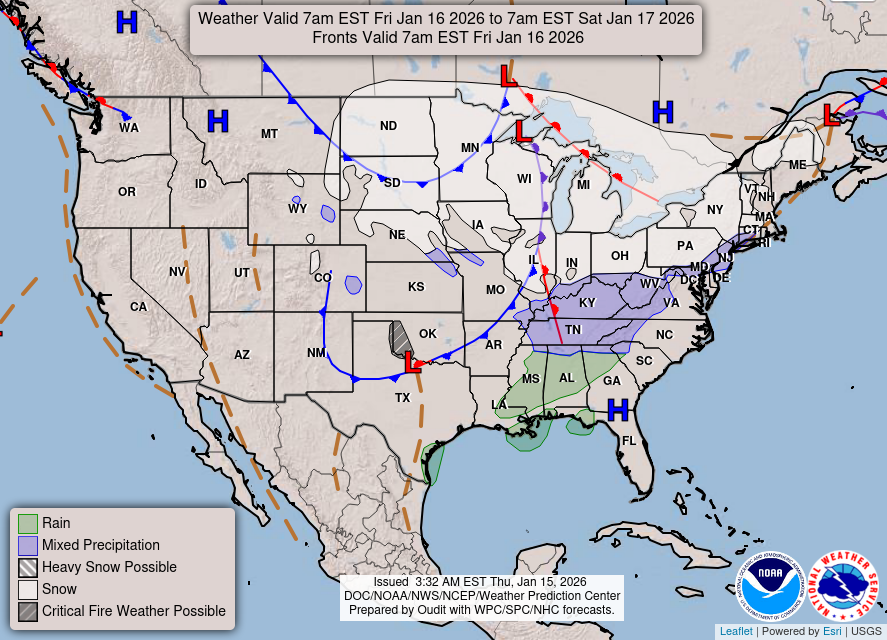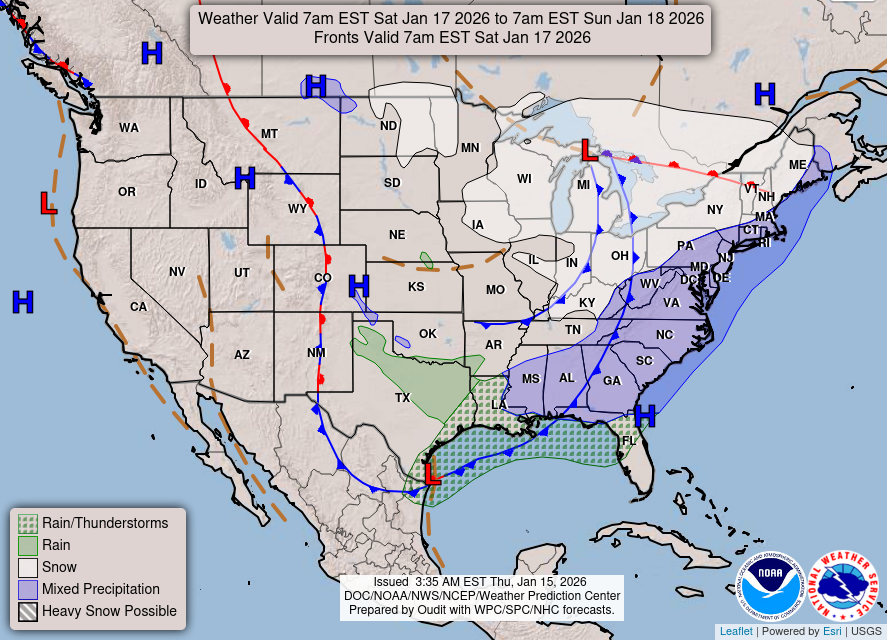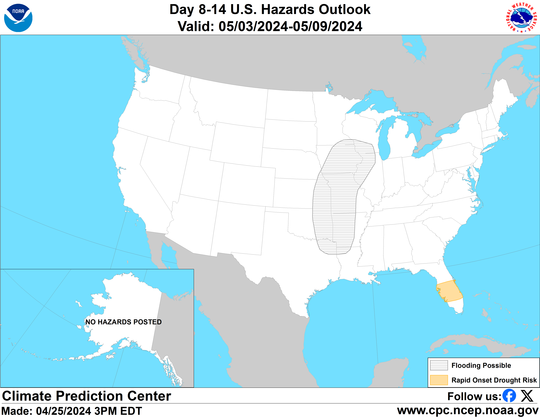This article focuses on what we are paying attention to in the next 48 to 72 hours. The article also includes weather maps for longer-term U.S. outlooks (up to four weeks) and a six-day World weather outlook which can be very useful for travelers.
First the NWS Short Range Forecast. The afternoon NWS text update can be found here after about 4 p.m. New York time but it is unlikely to have changed very much from the morning update. The images in this article automatically update.
Short Range Forecast Discussion
NWS Weather Prediction Center College Park MD
Thu Oct 17 2024
Valid 12Z Thu Oct 17 2024 – 12Z Sat Oct 19 2024…Powerful Pacific storm to bring much colder temperatures and widespread
mountain snow throughout the Intermountain West and Rockies over the next
few days……Heavy rain and scattered flash flooding possible across the southern
High Plains on Saturday……Above normal temperatures and gusty winds forecast across the central
and northern Plains today, resulting in fire weather concerns…As the calendar dives deeper into autumn, colder storm systems are
beginning to impact parts of the country along with wintry weather
conditions. The Intermountain West and Rockies will face the brunt of next
Pacific-bred storm system ushering in below average temperatures, gusty
winds, and heavy mountain snowfall. A cold front marching southeastward
will mark the sharp transition toward cooler temperatures and increasing
snowfall potential. This frontal boundary is anticipated to cross the
Intermountain West between today and early Friday before traversing the
central Rockies and stalling over the southern High Plains by Saturday.
Heavy snowfall is likely in the higher terrain (mainly above 7000-8000
feet) of south-central Montana, western Wyoming, Utah, and southwest
Colorado. As the system slows forward progress and increasing moisture
content surges up the southern High Plains, the potential for heavy
rainfall exists across eastern New Mexico into southeast Colorado.
Training north-south oriented lines of showers and storms could contain
intense rainfall rates while remaining over similar locations for a few
hours. This setup could produce scattered areas of flash flooding,
especially for poor drainage locations and urban regions. A Slight Risk
(level 2/4) of Excessive Rainfall has been issued for this part of the
country in order to further highlight the flooding threat. Additionally,
gusty winds are possible in the central Great Basin and Southeast as the
strong frontal boundary sweeps through over the next few days, this may
also lead to a strong offshore wind event throughout California. Wind
Advisories have been issued for parts of Nevada, Arizona, and California,
as well as Red Flag Warnings for parts of central and northern California
in order to highlight the fire weather danger.Fire weather concerns also exist throughout much of the central U.S. today
as strong southerly flow aids in producing above average temperatures and
low relative humidity. Red Flag Warnings span from Kansas to Minnesota and
reiterate the potential for fires to spread rapidly. These weather
conditions throughout the Plains and Midwest are in relation to a potent
high pressure system situated over the Ohio/Tennessee valleys that is
expected to settled over the East by the end of the week. Underneath this
high remains below average temperatures and for some places the first
frost or freeze of the season. Low temperatures are expected to drop into
the 30s and 40s for a majority of the eastern U.S. outside of the Florida
Peninsula, but even northern parts of the Sunshine State may need to break
out the sweaters the next few mornings. Temperatures will begin to
moderate by Saturday as afternoon highs into the 70s become more
widespread.Elsewhere, a separate Pacific system moving inland over British Columbia
on Friday will surge precipitation chances into western Washington.
Rainfall amounts over 2 to 3 inches are possible in the commonly-damp
Olympic Peninsula and northern Cascades.
To get your local forecast plus active alerts and warnings click HERE and enter your city, state or zip code.
Learn about wave patterns HERE.
Then, looking at the world and of course, the U.S. shows here also. Today we are looking at precipitation.
Please click on “Read More” below to access the full Daily Report issued today.
| Notices: What would you like to learn about? Please provide that to me via the comment section at the end of the article. |
Now more detail on the 48-Hour Forecast (It is a 48 to 72 Hour Forecast actually)
Daily weather maps. The Day 1 map updates twice a day and the Day 2 and 3 maps update only once a day. These maps update automatically. But if that does not happen, you can get updates by clicking HERE
TODAY (or late in the day the evening/overnight map will appear) (Key to surface fronts shown on maps and you will then also be able to insert a city name or zip code and get a local NWS forecast).

TOMORROW

NEXT DAY

We have a new animation of the forecast which shows how things may play out over the next 60 hours. To update click ANIMATION. Doing so will get you to the dashboard. You can then step through the animation or hit LOOP on the upper right of the display. You will have to hit the back arrow ← at the top left on your computer to get back into this article. It is a little more trouble than before but I think NOAA scrapped the animation routine I was using so we have to keep up with “progress”.
The NWS Climate Prediction Center’s: Watches, Warnings, and Advisories plus other information can be found HERE. That takes you to the NWC Severe Weather Site. From there you can select among many categories of information. Remember to hit the back arrow ← at the top left of your screen to return to this article.
ATMOSPHERIC RIVERS
This tells us what is approaching the West Coast. Click HERE to update If I have not gotten around to doing the update. Here is some useful information about Atmospheric Rivers.

Below is the current five-day cumulative forecast of precipitation (Updates can be found HERE)

Ski SnowReports will Resume in the Fall.
Now we look at Intermediate-Term “Outlook” maps for three time periods. Days 6 – 10, Days 8 – 14, and Weeks 3 and 4. An outlook differs from a forecast based on how NOAA uses these terms in that an “outlook” presents information as deviation from normal and the likelihood of these deviations.
Below are the links to obtain updates and additional information. They are particularly useful if you happen to be reading this article significantly later than when it was published. I always try to provide readers with the source of the information in my articles. These links may also be useful for those viewing this article on a cell phone or other small screen.
| Days 6 – 10 (shown in Row 1) | Days 8 – 14 (Shown in Row 2) | Weeks 3 and 4 (Shown in Row 3 but updates only on Fridays) |
| https://www.cpc.ncep.noaa. gov/products/predictions/610day/ | https://www.cpc.ncep .noaa.gov/products/predictions/814day/ | https://www.cpc.ncep.noaa.gov/products/predictions/WK34/ |
Showing the actual maps. They should now update automatically. The Week 3 – 4 Outlook only updates on Fridays. So below is what I call the Intermediate-term outlook. On Fridays, it extends out 28 Days. That declines day by day so on Thursday it only looks out 22 days until the next day when the Week 3 – 4 Outlook is updated and this extends the outlook by one additional week.
| 6–
10
|
|
|
| 8–
14 |
|
|
| 3–
4 |
|
|
HAZARDS OUTLOOKS
Click here for the latest complete Day 3 -7 Hazards forecast which updates only on weekdays. Once a week probably Monday or Tuesday I will update the images. I provided the link for readers to get daily updates on weekdays. Use your own judgment to decide if you need to update these images. I update almost all the images Friday Night for the weekend edition of this Weather Report. So normally readers do not need to update these images but if the weather is changing quickly you may want to.

Temperature month to date can be found at https://hprcc.unl.edu/products/maps/acis/MonthTDeptUS.png
Precipitation month to date can be found at https://hprcc.unl.edu/products/maps/acis /MonthPNormUS.png
World Forecast [that website is has been intermittent so be patient]
Below are the Day 1 -3 and 4-6 forecasts for temperature and precipitation. Updates and much additional information can be obtained HERE
World Temperature Anomalies


World Accumulated Precipitation


This information is provided by the University of Maine. They draw upon many different sources. There is a lot of information available at the link provided. I have just provided two useful forecasts. There are probably over a hundred different forecasts available from this source.
Worldwide Tropical Forecast (This is a NOAA Product)
This graphic updates on Tuesdays) If it has not been updated, you can get the update by clicking here Readers will only have to do that if they are reading this article much later than the date of it being published.
Information on Tropical Storms can be found HERE. Western Pacific information can be found HERE. Note that unless there is an out-of-season storm the below images will not update until the National Hurricane Center starts their seasonal update of these maps on June 1. I include them simply because there can be an out-of-season event in which case it should show up in these maps.


–
| I hope you found this article interesting and useful. |








